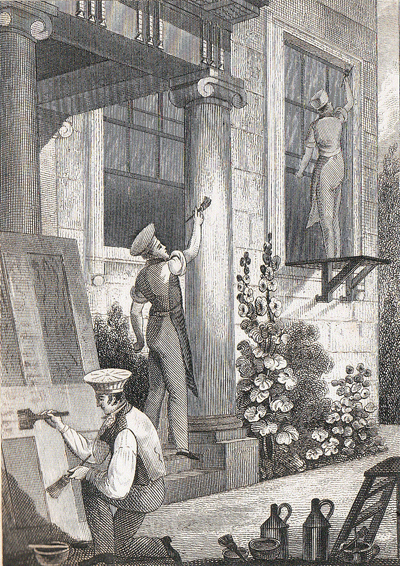Choosing suitable paint for period properties
Patrick elaborates on choosing paints for your period house – and warns owners not to be swayed by marketing ploys

"...and, of course, we used Milk Paint on the drawing room walls"
Paint is the Cinderella of the decorator's world: ignored for being messy or tediously complicated by many, yet the darling of the coffee table when it comes to one-upmanship.
A blend of colouring matter and binder, paint comes in a bewildering number of types, often made more complex by clever branding and marketing. Working out what might be suitable for a period property can be difficult, but if you are equipped with the bare facts it need not to be.
Simply put, the basic types used for the decoration of houses in the eighteenth and nineteenth centuries were twofold - a paint based on lead carbonate ground in oil and a water-based "soft" distemper composed of chalk, water and a glue binder. Bar a few specialist applications both are now outdated. Lead paint is all but impossible to get a hold of, largely due to legitimate concerns about its effect on health. Distemper has eco-friendly credentials but is fragile and needs to be made up the night before use. If these differences are understood, the selection of a suitable paint for use in an historical building is made much easier.
Of course, one may still be swayed by the attractive tin label, various marketing ploys or the desire to keep up with the neighbours, but often the somewhat more mundane paint products that can be obtained from the local trade counter or the big DIY ‘sheds' are just as suitable. This is not to say that a cheaper paint is better than a more expensive one - frequently this is far from the case - merely that details other than price need to be looked at. As long as the technical and aesthetic needs of the building and its occupants are answered the range of options is extensive.
If it is accepted that a true traditional paint is seldom practical or even available you will have to research alternative options. Certainly look out for the water-based products if keen to do the sensible thing in terms of the environment. Don't employ an oil-based paint purely because it would have been used originally. As the paints and their constituents are so very different nowadays it makes no sense to worry about playing the purist card. Yes, an eighteenth century oil paint might have had linseed oil as a component, but that was ground with lead which produced a near-perfect blend. Modern "linseed oil paint" is mixed with titanium dioxide, the white component of tooth paste and sun cream, which has very different properties.

Of course, any suggestion that modern paints are perfectly suitable for the decoration of historical buildings must be qualified. For those buildings with special needs like those built of cob or rammed earth; of early buildings without damp-proof courses, or those with damp problems, it is essential to ensure that the particular requirements of the building are met. However let's not get too carried away with the belief that all buildings need to "breathe" as has been pointed out in my last article. Quite simply they don't and most painted surfaces in old buildings have been unable to "breathe" for two to three hundred years.
Sign up for the Country Life Newsletter
Exquisite houses, the beauty of Nature, and how to get the most from your life, straight to your inbox.
This isn't always what the owner of such a building wants to hear. Surely it must be more difficult than that? Naturally, colour and finish are paramount and this is where the cheaper brands can look very two-dimensional and care is required in the selection. As the most expensive element of a paint is the colourant (please note, not "pigment") it will come as no surprise to learn that the less expensive varieties tend to use as little as the manufacturers can get away with, leaving some paints looking very flat. The intelligent colourist will combine four or more different colourants, producing a colour with more depth and one that may appear different under varying light conditions. In short it will have "texture" and interest which, along with an appropriate colour choice, will provide a more sympathetic result.
Above all, don't think that the painting of an historical building necessitates the use of bad paint. For too long such has been packaged and sold under the guise of a traditional product. There is no reason why the paint that is applied should rub off or mark when touched. If it does you are allowing reason to be clouded by clever marketing.

Patrick Baty is a consultant on historic paint and colour. He also has a shop in London where you can not only get expert advice, but they will mix authentic and any number of other colours.
Country Life is unlike any other magazine: the only glossy weekly on the newsstand and the only magazine that has been guest-edited by HRH The King not once, but twice. It is a celebration of modern rural life and all its diverse joys and pleasures — that was first published in Queen Victoria's Diamond Jubilee year. Our eclectic mixture of witty and informative content — from the most up-to-date property news and commentary and a coveted glimpse inside some of the UK's best houses and gardens, to gardening, the arts and interior design, written by experts in their field — still cannot be found in print or online, anywhere else.
-
 Everything you need to know about private jet travel and 10 rules to fly by
Everything you need to know about private jet travel and 10 rules to fly byDespite the monetary and environmental cost, the UK can now claim to be the private jet capital of Europe.
By Simon Mills Published
-
 'I'd willingly give a year of my life for a fortnight there': The green dream that is the garden of Derreen
'I'd willingly give a year of my life for a fortnight there': The green dream that is the garden of DerreenExotic woods, labyrinths of narrow, mossy paths and thousands of tree ferns make this an internationally important garden, writes Charles Quest-Ritson. Photographs by Jonathan Hession.
By Charles Quest-Ritson Published
